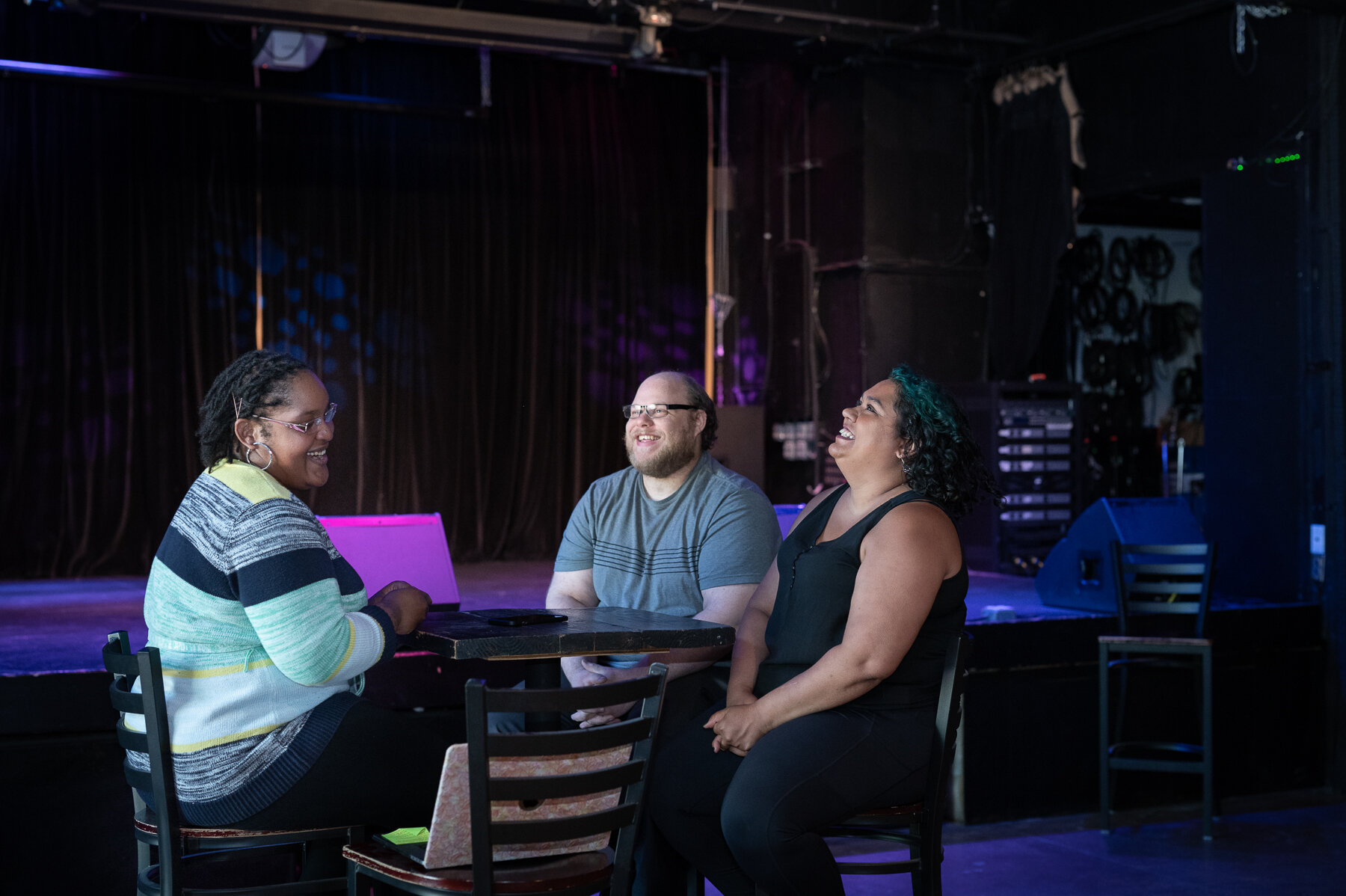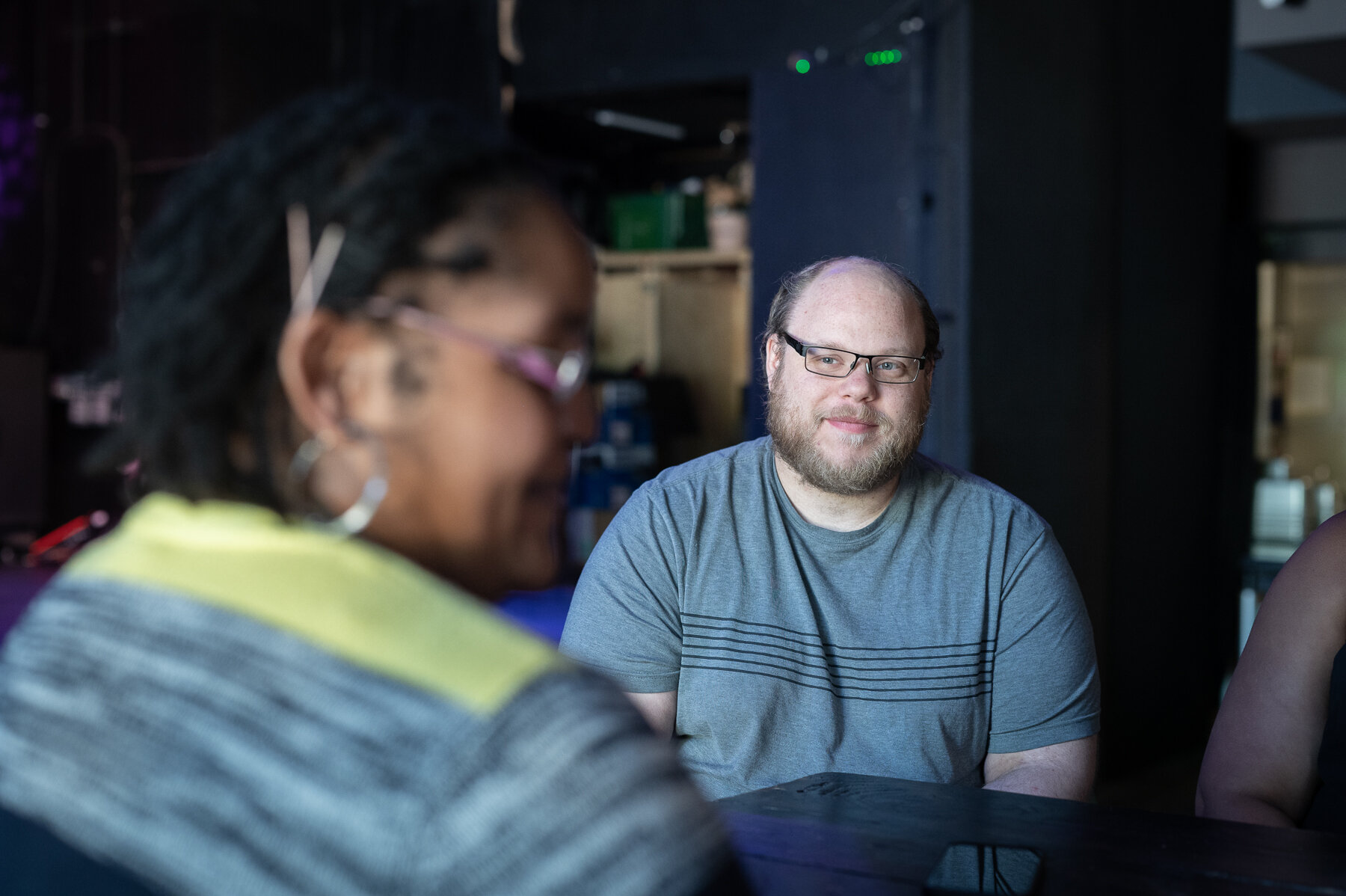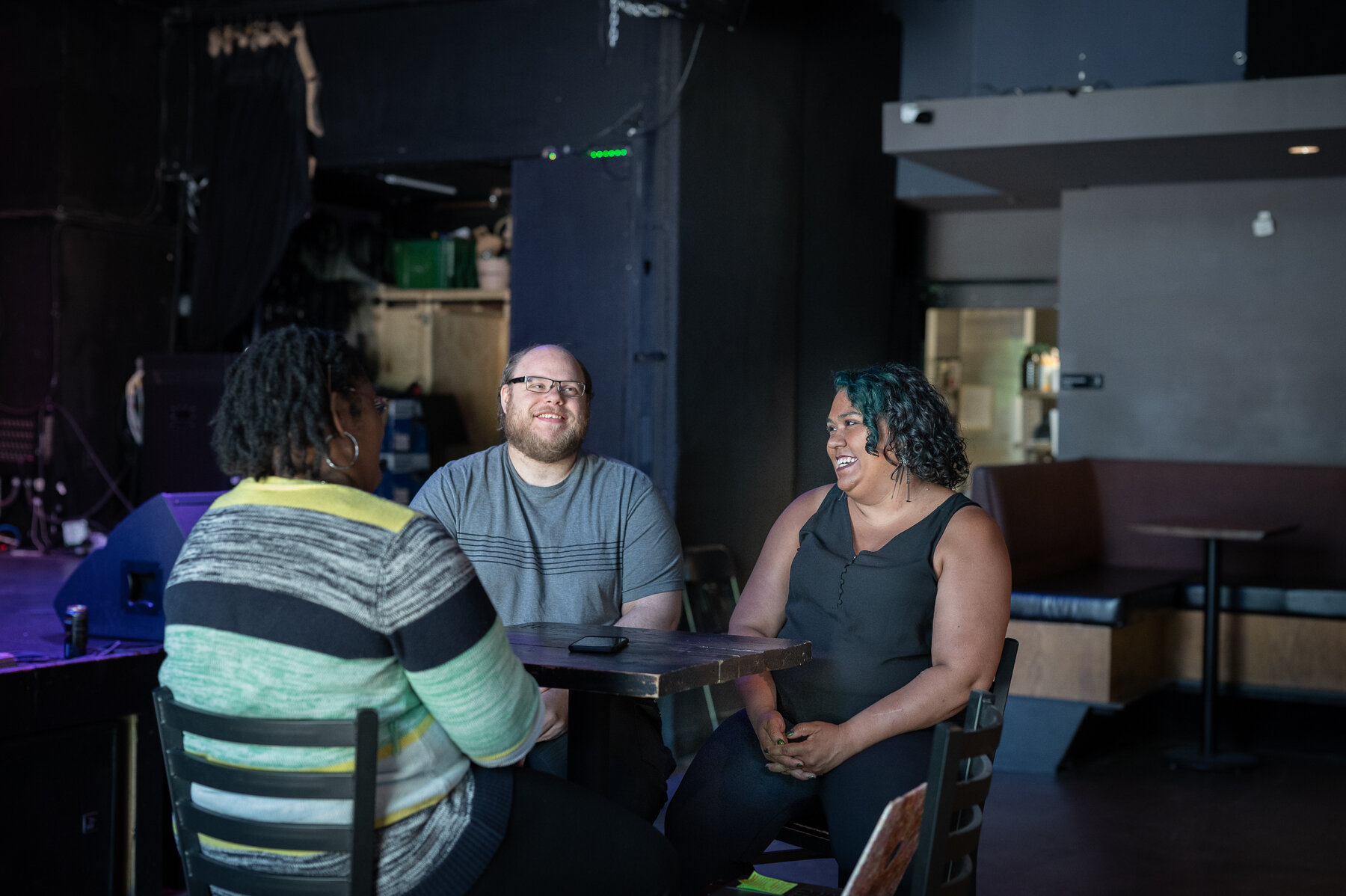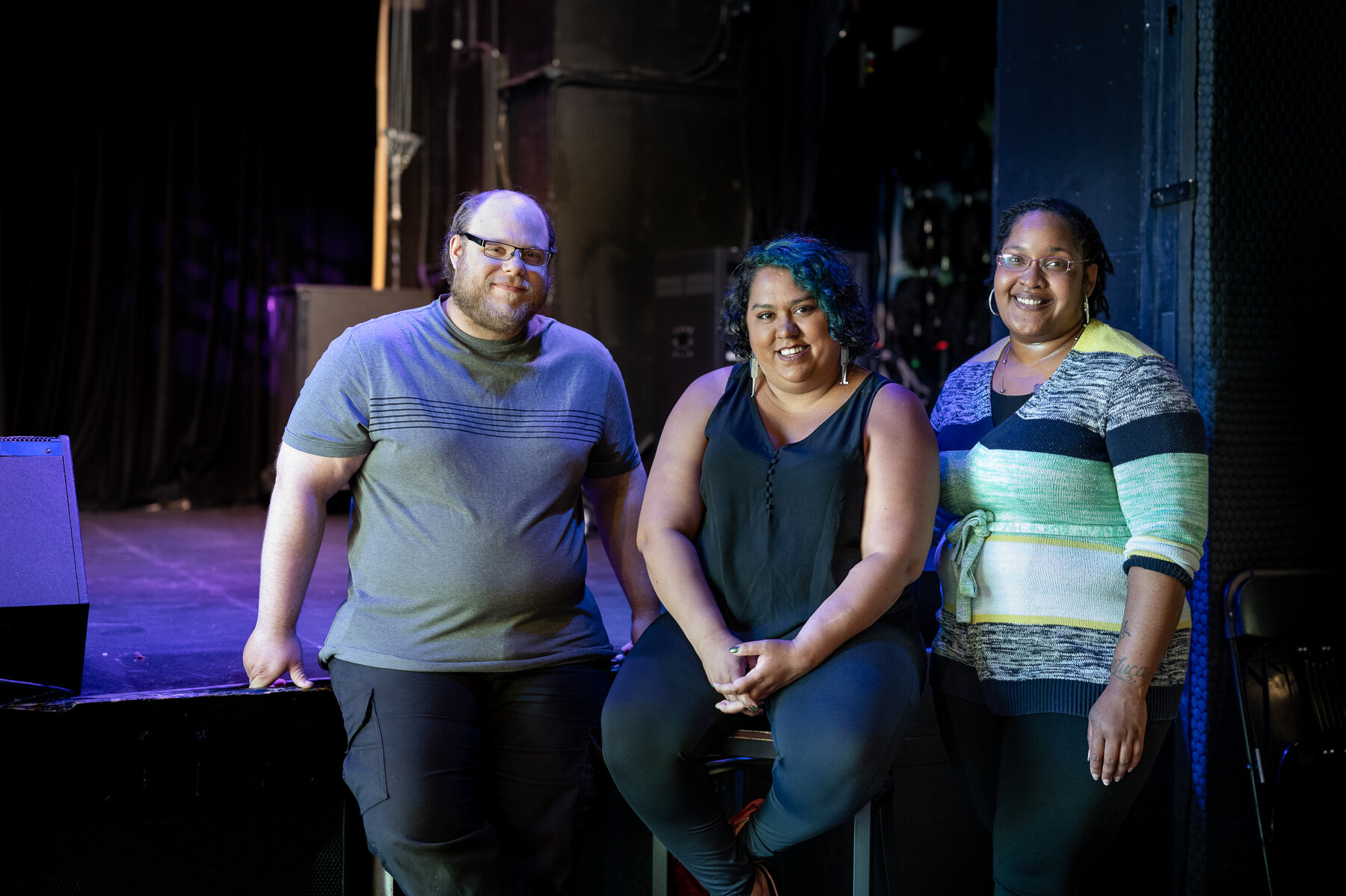Sound Check at Amsterdam Bar & Hall in St. Paul
Interview by PaviElle French | August 12, 2021
Amsterdam production manager Steffan Soulak and operations and entertainment manager Brenda Peters. Photo by Chad Holder.
FEATURE
In a new series of interviews exploring the intricacies of sound design and engineering in performance spaces across the Twin Cities, interdisciplinary artist and ENTER contributing editor PaviElle French visits with sound professionals in the rooms they know best. First tour stop: Amsterdam Bar & Hall in St. Paul, co-owned by architectural designer Lyssa Washington, Assoc. AIA, NOMA, Josh Mandelman, Jon Oulman, and Jarret Oulman. Amsterdam’s operations and entertainment manager Brenda Peters and production manager Steffan Soulak sat down with PaviElle in June for a lengthy conversation on topics as technical as frequencies and feedback and as simple as remembering to turn the ice machine off during classical music shows.
PaviElle French: Thank you so much for speaking with me. I’ve been looking forward to this, because I think a lot of people are curious to learn about all that goes into optimizing the sound experience in music clubs and concert halls. I’ve been performing since I was five, and even I have questions!
Brenda Peters: Thank you for the invitation, PaviElle!
Steffan Soulak: Yes, thank you. It’s a pleasure to be here.
PF: Before we dive into the technical side of sound, let’s talk a little about the history of Amsterdam Bar & Hall. I’ve always assumed this space was a club venue from the start. Is that true?
BP: A very interesting thing about this space is that it used to be fine dining. First it was Fhima’s, then Pop. The whole room was a restaurant up to about here [on the dance floor], and what is now the stage, back hallway, and part of the green room was the kitchen—I mean, a full kitchen. We came in and redid the space entirely, adding pretty much everything you see in here, except for the main bar. It was a big challenge to [convert] an industrial kitchen with a lot of HVAC above it. Even things like the curtains on the back wall assist in making the stage sound like a stage, not just a space with a platform built into it.
The interview took place in the Amsterdam music hall, in front of the stage. Photos by Chad Holder.
SS: We also have really thick ceilings because the parking structure is above us. Which is amazing—I didn’t know that the first four times I was in here.
BP: The only time I’ve been able to hear the parking garage is when they come through with industrial power washers. That you can hear; it sounds like a distant thunderstorm. Otherwise, you’d never know there are cars above us all the time.
PF: Is there soundproofing that helps with that?
BP: If I’m not mistaken, the floor slabs are 16 inches of concrete.
SS: We also have an acoustic spray foam up there. You can see on that beam [in the stage area] how it’s about three or four inches thick. And that’s sprayed over the whole ceiling.
PF: I always thought that was just an aesthetic coating for pipes that would otherwise be exposed. So, do sound waves bounce off cement more than they do, say, wood surfaces?
SS: Right, wood absorbs a lot more, which is why we have [wooden] booths along the sides. They do help, especially with sideways bounces.
PF: Sideways bounces? What would make that happen?
SS: Mostly the mains—the top speakers. They way they’re designed, they have a wider spread to the sides, and not as much height. That’s how we cover an audience without hitting too much on the cement floor or wasting energy up in the ceiling. We’ve also got sound-dampening panels behind the curtain at the back of the stage.
BP: [Over by the stage] that wall moves, and that wall has some sound-dampening properties as well. I mean, we’re never going to have a show on this side [the music hall] that you can’t hear over there [the main bar area]. But the walls make a huge difference when you have a show with acoustic guitars or classical music, as opposed to rock ’n’ roll. Those are two very different things to mix for in a room.
“There are nights when metal bands bring in extra stacks and seven drum kits, and the show is ear-bleedingly loud. And others when everyone is quiet and respectful for the classical performances. Both kinds of shows sound great, and a very big part of that is how our engineers make the room work for what is being played in it.”
PF: I’m interested in how you set up for classical music shows.
BP: One of the things we’ve done in the past with classical music is temporarily turn off the extra air blowing over the stage. The room is so quiet. We even turn the ice machine off in the kitchen because any random ambient noise is incredibly impactful during a classical show.
SS: I think we even go to plastic cups, instead of glass.
BP: Exactly, so there’s no clinking of glass as people set their glasses down. But audiences for classical shows are also coming with a different set of expectations than audiences for rock shows. Everybody in the room is working with the idea that this is going to be a quieter, more impactful experience.
PF: Mm-hmm, and intimate.
BP: Yes, very intimate. Particularly with the kind of show we once did where we had the quartet on the floor and some audience seating up on the stage.
PF: I am amazed by how versatile this room can be. All the times I’ve come here to perform, I’ve been too busy loading in and sound-checking to take in everything around me. I never would have imagined classical music at Amsterdam.
BP: Well, it’s really fun to be more than a one-genre room. There are nights when metal bands bring in extra stacks [amplifiers] and seven drum kits, and the show is ear-bleedingly loud. And others when everyone is quiet and respectful for the classical performances. Both kinds of shows sound great, and a very big part of that is how our engineers make the room work for what is being played in it.
Performer and sound engineer at the soundboard. Photo by Chad Holder.
PF: A perfect segue! Steffan, I’m really curious, as a performer, to know what you listen for during sound checks.
SS: I start by listening for obvious issues like misplaced mics or an imbalance in volume between instruments. Next, I listen for things like a guitar that’s too bass-y, making the mix muddy and undefined. After balancing everything and removing unwanted environmental factors, I just try to capture what’s happening on stage. I mask some imperfections, but not all of them, because the imperfections are what makes the music live music, gives it soul.
To get a little more technical, I listen to frequencies and obviously the feedback. The room actually has resonating frequencies. So, I listen for those and maybe cut them out a bit, so they’re not overpowering in the room. A lot of low end [bass] will just stick around.
PF: Yeah, it just reverberates. Does the amount of people in the room make a difference? Do 100 people soak up more sound than 30?
SS: Yes, for sure. When you have a full room, the sound doesn’t travel as far, so you’ve got to push it up a little more. And when the room is empty, there’s just a ton of reverb. Things do change between sound check and live performance, depending on how much the room fills up.
PF: I always ask venues if the band and I can do a quick sound check right before we start the show, so we get the actual sound/feel in the room. Is a five o’clock sound check in an empty room still helpful prep?
SS: Yeah, we can get about 95 percent of the way there. Some of the frequencies and standing waves will change a little bit from sound check to live show, but you can set it up ahead of time and get almost all the way there. And once you do that, all the other bands [on stage that night] fall into those same presets, because it’s a digital board. You just tweak things throughout the night.
PF: When you do sound, are you using headphones or just listening to the room? Or is it a mix of the two?
SS: If there are complicated things happening on stage—say, a lot of tracks or something intricate like classical—I’ll use headphones to make sure I’m hearing everything correctly. But most of the time, I’m just walking around the room and listening, making adjustments on the digital soundboard from my iPad.
PF: I imagine that tool—a remote connection to the soundboard—was a welcome one when it first became available. Before that, you had to set sound levels, get up, walk around, come back, and make adjustments, several times over.
SS: Definitely. One of the most important things is, I can talk with the artist on stage as I’m working. Sometimes they say, “Something’s wrong, but I don’t know what it is.” You might have experienced this during a sound check, too—not knowing exactly how to convey what needs to change.
PF: Yes!
SS: With the iPad, I’ll adjust a level, and they’ll say, “That!”
PF: Yeah, for me, it usually has to do with the bass or the tenderness of my voice. I’m like, “I need some extra oomph. Can you put something on it?”
Post-interview conversation at the bar. Photo by Chad Holder.
BP: One of the fascinating things about music is that we all speak a different language. I don’t have anywhere near the technical understanding that Steffan does, so sometimes I have to have him explain things to me like I’m a five-year-old, because I don’t know what he’s talking about. Along the way, I’ve learned new words for different sound qualities.
SS: Yes, like “milky” or “sizzle.” What is the milkiness of the bass? It doesn’t make sense to some ears.
BP: I would never have thought to use that term!
SS: Or the drums sound “crunchy.” Of course, another engineer will know exactly what I’m talking about.
PF: Right! What a wealth of information and insight, you two. Thank you again for joining me.
BP: No problem, PaviElle!








